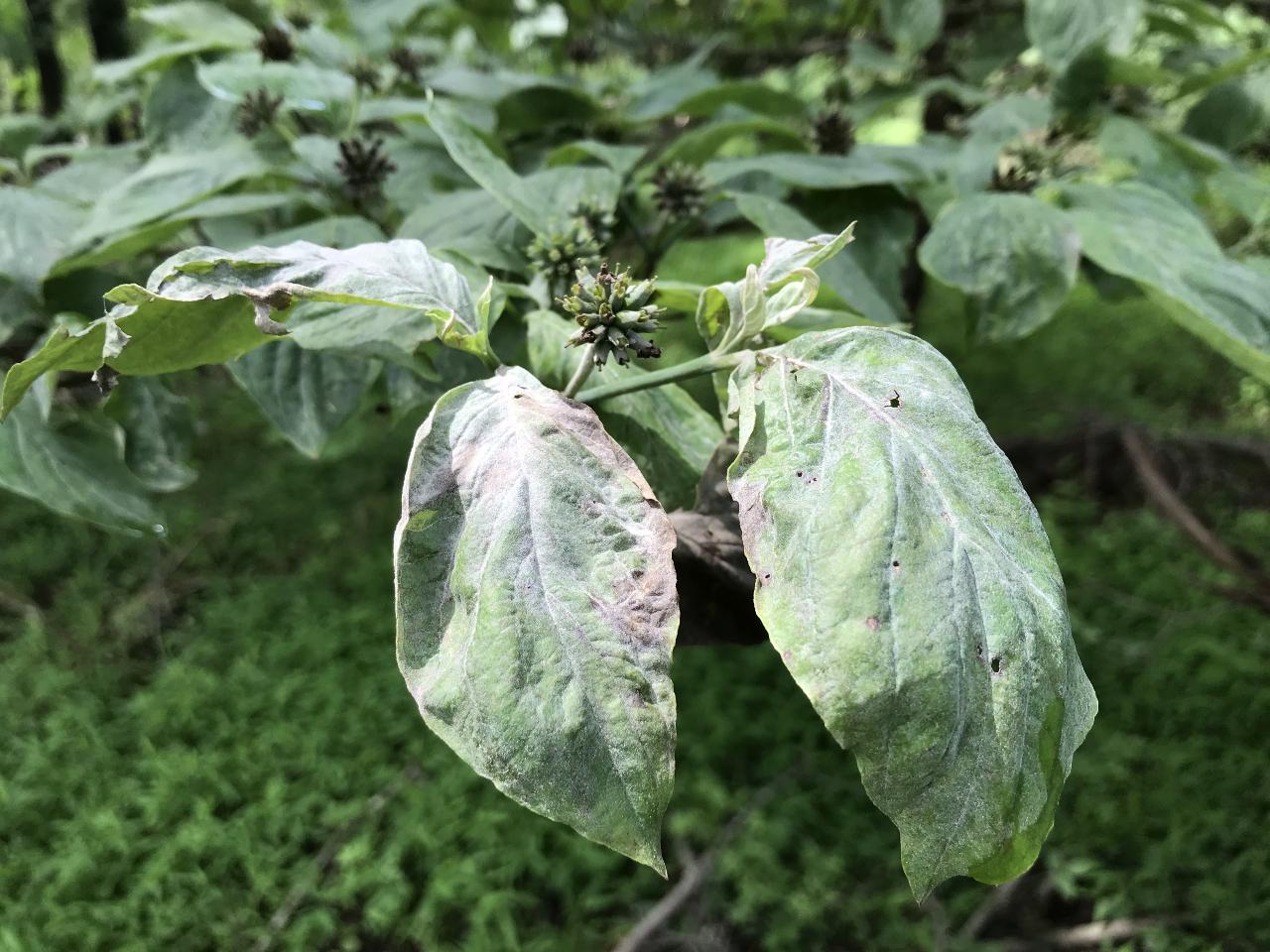
Powdery mildew is a common disease of flowering dogwoods. Photo: M. Talabac, UME
Flowering dogwood (Cornus florida) is a relatively small flowering tree that is popular in Maryland home landscapes. Although it is a native species, it is susceptible to several diseases, pests, and abiotic (nonliving) problems that can reduce the quality of flowering and overall growth. Selecting disease-resistant cultivars and using good growing practices will reduce the chances of these problems.
Use this picture guide (or the text table below) to identify the most common problems of flowering dogwoods and related Cornus species.
Location of Symptoms - Leaves and Petals
Powdery Mildew


- Symptoms: white coating on leaves; may be on upper and lower surfaces.
- Powdery mildew (caused by fungal pathogens Erysiphe and Phyllactinia guttata) has become a more severe and widespread problem in Maryland in recent years.
- Symptoms may be visible on leaves from early summer through fall. In some years the powdery appearance is less evident.
- Under severe conditions, the new leaves can exhibit leaf scorch, twisting, distortion, and smaller than normal growth.
- Older infected leaves often develop purple blotches that progress to dead areas.
- Infections cause the loss of water and photosynthetic leaf area which weakens trees and reduces growth.
Elsinoë Leaf Spot
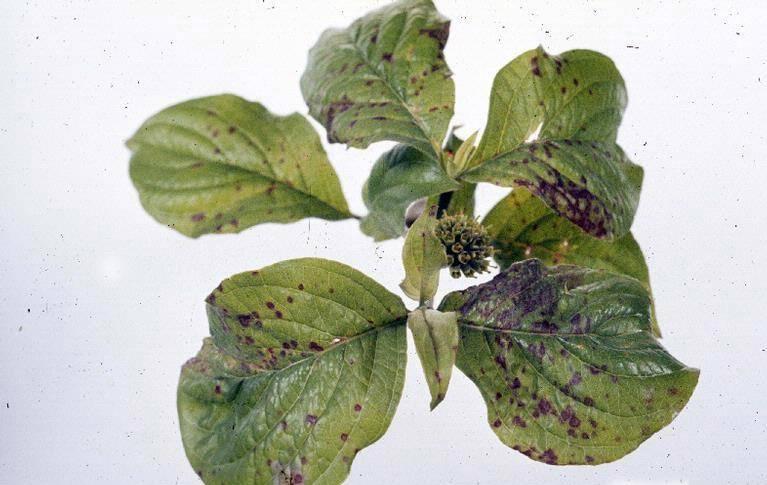

- Symptoms: spots, 1/8 inch or smaller with purple borders, appear on the leaves or flower bracts in the spring.
- Elsinoë Leaf Spot (also called Spot Anthracnose) is a fungal disease that is favored by wet spring weather.
- When numerous, the spots can cause leaves and flower bracts to become wrinkled and distorted.
- This is a common disease and is not severe.
Leaf and Flower Petal Blight

- Symptoms: spotting on the flower bracts to complete collapse of the bracts; gray, fuzzy growth on terminal leaves and flowers.
- This is caused by a fungus, Botrytis cinerea, commonly called "gray mold."
- Infected bracts that fall onto leaves can also cause leaf and twig infections.
- This disease can be serious during wet spring weather.
- Generally, no chemical controls are needed for this disease because drier weather will stop disease progression before serious damage occurs.
Dogwood Anthracnose

- Symptoms: dark spots on leaves and flower bracts; blighted leaves; twig dieback; reduces flowering, causes defoliation (spring).
- Dogwood anthracnose is caused by a fungal pathogen, Discula destructiva.
- In the past, this was the most serious disease of flowering dogwoods in the landscape and our forests but it is now less common.
- The early symptoms begin in mid-to-late May as leaf spots with tan or purple borders. In wet weather, these spots can rapidly enlarge and kill the entire leaf.
- The disease spreads from infected leaves into the twigs and branches and can cause dieback of the limbs.
Other Leaf Spots

- Other leaf spots caused by fungi may appear late in the growing season and rarely cause much damage; fruit may shrivel or become discolored in severe outbreaks.
- Septoria corincola is the most common cause; other minor leaf-spot pathogens include Phyllosticta and Cercospora.
- Septoria causes dark spots that are circular to angular in shape with purple borders and are about ¼ inch in diameter. Occasionally, very small black dots are visible inside these spots that indicate where the infectious spores are formed.
-
Generally, no chemical controls are needed for these late-season diseases. Rake and dispose of leaves in the fall to reduce disease incidence.
Leaf Scorch

- Symptoms: browning along leaf edges and a dropping or wilted appearance of the leaves.
- Leaf scorch occurs on drought-stressed trees, when the amount of water leaving the plant (transpiration) exceeds the amount of water uptake by the roots.
- Leaf scorch alone rarely kills a tree but it can weaken the tree or can make it more susceptible to pests and diseases.
- Avoid this problem by planting in a location where your tree will receive partial shade and supplemental moisture during hot, dry weather. Soil should be somewhat moist but not saturated.
Early Fall Color

- Symptoms: leaves change color (red, purple, or bronze) prematurely (summer); leaves may have brown edges/wilting; peeling, cracked bark near the base of the tree.
- These symptoms are indicators of stress, which may be caused by powdery mildew, drought conditions, poor site conditions, and/or crown canker.
Dogwood Sawfly


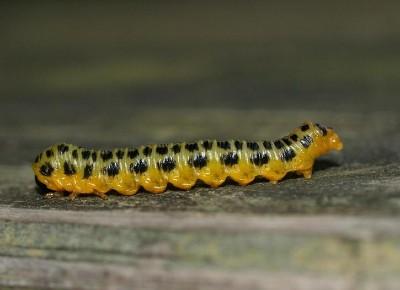
- Symptoms: leaves are chewed or eaten entirely.
- The dogwood sawfly is an occasional pest of dogwoods. They are mostly seen on shrub dogwoods - e.g., silky dogwood (Cornus amomum) and red osier dogwood (C. sericea).
- The larvae (juveniles) resemble caterpillars and feed on the foliage.
- Adult sawflies, which resemble tiny wasps, emerge during late spring and early summer.
- The female lays eggs on the undersides of the leaves.
- Upon hatching, the young larvae feed together and chew the leaves.
- After the second molt, the larvae become covered with a white powdery material.
- After their final molt, they lose the powdery covering and change color. The mature larvae are yellowish with a shiny black head and black spots.
- These mature larvae will wander about in search of an overwintering site, generally in soft or decaying wood.
- There is one generation each year. Monitor for them starting in early July.
-
Management is seldom needed, but if desired, wear gloves and manually remove and discard the larvae.
-
If an infestation is heavy, particularly on a young plant, the larvae may be sprayed with horticultural oil registered for landscape use. Apply according to the label instructions.
Location of Symptoms - Twigs, Branches, Trunk
Twig and Branch Canker

Photo: University of Maryland Extension
- Symptoms: sunken discolored areas on twigs and small branches.
- These cankers are caused by fungal pathogens (Botryosphaeria sp. and Diplodia sp.) and are rarely serious but can lead to limb dieback. The fungus Botryosphaeria appears to be more severe on pink flowering cultivars.
- Healthy plants are less susceptible to these diseases. Water during droughts and avoid over-fertilization to prevent excessive succulent growth.
- There are no effective chemical controls for this disease once diagnosed, so prune out infected branches promptly.
Dogwood Borer
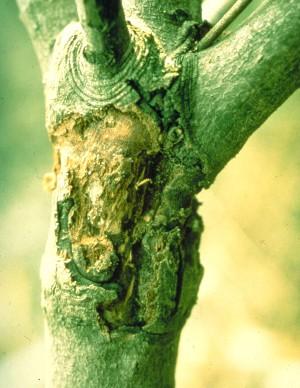

- Symptoms: Small, wet areas on the bark, dead branches, adventitious growth (water sprouts on the trunk and large branches), and cracking of bark.
- Small trees or individual branches can be girdled and killed in one to two seasons.
- Larger trees with ongoing infestations often develop rough, knotty areas on the trunk and large branches, and may lack vigor.
- The dogwood borer (Synanthedon scitula) most frequently attacks trees that are stressed or injured.
- The adult is a day-flying clearwing moth. Adults emerge from dogwood trees around mid-May and continue throughout most of the summer.
- The female moth lays her eggs on the bark of the tree and is particularly attracted to injured bark, scars, and other rough areas on the trunk.
- Upon hatching, the young caterpillar finds a suitable place to enter the tree such as a wound, scar, woody gall, or branch crotch. It will feed just under the bark in the cambium layer. There is one generation each year.
Dogwood Twig Borer


- Symptoms: twigs die and break off as a result of feeding by the dogwood twig borer (Oberea tripunctata). This is a minor pest of dogwood.
- The adults beetles are 5/8 inch long with long antennae. They have yellow/tan wing covers with a black line down the center and along the margins. There are two distinctive black dots just behind the head.
- The adult beetle emerges from infested twigs in the spring and the female lays her eggs in healthy twigs.
- The larvae (juveniles) are yellowish in color. They tunnel into the spongy center of twigs and may expel sawdust as they feed.
- There is only one generation each year, with the larva overwintering inside the twig.
- Infested twigs should be pruned off several inches below the girdled or infested portion and destroyed. This should be done after wilting occurs and before adult emergence in the spring.
Flatheaded Appletree Borer

-
Symptoms: cracked bark near the base of young trees and large branch dieback.
-
This can be a serious problem on young trees that are planted too deeply and on older, stressed trees.
-
The adult beetles appear in the summer and feed on the foliage. They may be seen running over the bark and fly away when disturbed. They are 1/2 inch long, oval, flattened, greenish bronze above, and brassy below.
-
The larvae (juveniles) are called creamy-colored with an enlarged flattened area behind the head. They make large, irregular tunnels under the bark of the trunk and large branches.
Crown Canker Of Dogwood (Collar Rot)
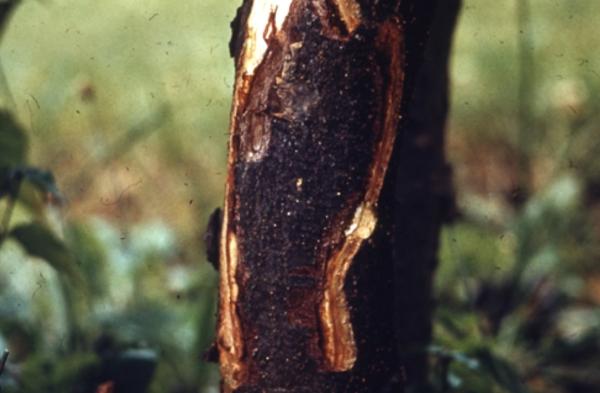
- Symptoms: smaller than normal leaves, pale green leaves, and early red fall coloration, especially on individual branches along one side of the tree. Later, the canker forms a sunken area on the trunk. The bark will dry and crack, exposing the wood underneath. When a canker completely girdles the trunk, the tree will die shortly thereafter.
- This serious disease of dogwoods usually results from an injury to the bark near the base of the trunk that is invaded by this fungus-like organism called a water mold (Phytophthora cactorum and P. cinnamomi).
- There are no chemical fungicide controls for this disease once symptoms are visible.
- Do not replant dogwood trees in the same spot where a diseased tree was growing.
Location of Symptoms - Whole Plant
Stressed Tree

Symptoms: leaves wilting, smaller than normal leaves, pale green leaves, early fall red coloration; poor appearance overall.
Trees that are stressed due to unsuitable cultural and environmental conditions such as flooding and drought are more susceptible to diseases and pest problems.
Table: Common and Minor Dogwood Problems
This text table includes the common problems of dogwoods as well as minor, occasional pests of lesser significance.
| Symptoms | Details | Possible causes | Frequency |
|---|---|---|---|
| White Coating on Leaves |
May be on upper and lower surfaces (usually spring only); causes early fall color symptoms (purple/red leaf color) |
Powdery Mildew | Common |
| Leaf and Flower Spots |
Spots on leaves or flower bracts; 1/8 inch spots or smaller (spring) |
Common | |
| Leaf and Flower Blights |
Gray, fuzzy growth on terminal leaves and flowers |
Petal Blight (Botrytis cinerea) | Common |
| Leaf and Flower Spots | 1/4 inch angular spots on leaves (fall) |
Septoria Leaf Spot (Septoria cornicola) or to a lesser extent Phyllosticta or Cercospora |
Common (but minor in severity) |
| Leaf and Flower Spots |
Dark spots on leaves and flower bracts; blighted leaves; twig dieback; reduces flowering, causes defoliation (spring) |
Dogwood Anthracnose (Discula) | Not common |
| Leaves Browning | Browning leaf edges, leaves drooping, wilting | Drought stress, leaf scorch | Occasional |
| Early Fall Color (Summer) | General stress. Peeling, cracked bark near the base of the tree, brown leaf edges/wilting purple/red leaf color | Leaf scorch, powdery mildew, drought, poor site conditions, crown canker | Occasional |
| Leaves Eaten or Chewed | Sawflies resemble caterpillars (often covered with white powdery material) | Dogwood Sawfly | Occasional, usually on shrub dogwoods |
| Leaf Yellowing | Leaves may also have honeydew and sooty mold | Calico Scale or Cottony Maple Scale | Occasional |
| Leaf Yellowing | No honeydew | Oystershell Scale | Occasional |
| Twig Dieback | Twigs may break off | Dogwood Twig Borer | Occasional |
| Twig Dieback | Sunken, discolored areas on twigs | Branch Cankers | Occasional |
| Twig Dieback | Small green galls on terminal twigs, twigs may die prematurely | Dogwood Clubgall Midge | Infrequent |
| Twig Dieback | Leaf yellowing and stunting precede dieback | Armored Scale or Soft Scale | Occasional |
| Branch Dieback | Rough, knotty areas on trunk and large branches | Dogwood Borer | Occasional |
| Branch Dieback | Cracked bark near the base of young trees, large branch dieback | Flatheaded Appletree Borer | Occasional |
| Branch Dieback | Sunken, discolored areas on twigs | Branch Cankers | Occasional |
| Branch Dieback | Peeling, cracked bark near the base of the tree | Crown Canker | Occasional |
| Failure to Flower | Damaged flower buds | Can be weather or disease-related | Occasional |
| Poor appearance overall | Leaves wilting, smaller than normal leaves, pale green leaves, early fall red coloration | Stress from drought conditions, poor site conditions, powdery mildew, crown canker | Occasional |
Authors: Mary Kay Malinoski, Principal Agent, University of Maryland Extension (retired) and David L. Clement, Principal Agent, University of Maryland Extension, Home and Garden Information Center. Edited and revised by Christa K. Carignan, Coordinator, University of Maryland Extension, 12/2019, 8/2022.
Related information
Still have a question? Contact us at Ask Extension.
 English
English العربية
العربية Български
Български 简体中文
简体中文 繁體中文
繁體中文 Hrvatski
Hrvatski Čeština
Čeština Dansk
Dansk Nederlands
Nederlands Suomi
Suomi Français
Français Deutsch
Deutsch Ελληνικά
Ελληνικά हिन्दी
हिन्दी Italiano
Italiano 日本語
日本語 한국어
한국어 Norsk bokmål
Norsk bokmål Polski
Polski Português
Português Română
Română Русский
Русский Español
Español Svenska
Svenska Català
Català Filipino
Filipino עִבְרִית
עִבְרִית Bahasa Indonesia
Bahasa Indonesia Latviešu valoda
Latviešu valoda Lietuvių kalba
Lietuvių kalba Српски језик
Српски језик Slovenčina
Slovenčina Slovenščina
Slovenščina Українська
Українська Tiếng Việt
Tiếng Việt Shqip
Shqip Eesti
Eesti Galego
Galego Magyar
Magyar Maltese
Maltese ไทย
ไทย Türkçe
Türkçe فارسی
فارسی Afrikaans
Afrikaans Bahasa Melayu
Bahasa Melayu Kiswahili
Kiswahili Gaeilge
Gaeilge Cymraeg
Cymraeg Беларуская мова
Беларуская мова Íslenska
Íslenska Македонски јазик
Македонски јазик יידיש
יידיש Հայերեն
Հայերեն Azərbaycan dili
Azərbaycan dili Euskara
Euskara ქართული
ქართული Kreyol ayisyen
Kreyol ayisyen اردو
اردو বাংলা
বাংলা Bosanski
Bosanski Cebuano
Cebuano Esperanto
Esperanto ગુજરાતી
ગુજરાતી Harshen Hausa
Harshen Hausa Hmong
Hmong Igbo
Igbo Basa Jawa
Basa Jawa ಕನ್ನಡ
ಕನ್ನಡ ភាសាខ្មែរ
ភាសាខ្មែរ ພາສາລາວ
ພາສາລາວ Latin
Latin Te Reo Māori
Te Reo Māori मराठी
मराठी Монгол
Монгол नेपाली
नेपाली ਪੰਜਾਬੀ
ਪੰਜਾਬੀ Afsoomaali
Afsoomaali தமிழ்
தமிழ் తెలుగు
తెలుగు Yorùbá
Yorùbá Zulu
Zulu ဗမာစာ
ဗမာစာ Chichewa
Chichewa Қазақ тілі
Қазақ тілі Malagasy
Malagasy മലയാളം
മലയാളം සිංහල
සිංහල Sesotho
Sesotho Basa Sunda
Basa Sunda Тоҷикӣ
Тоҷикӣ O‘zbekcha
O‘zbekcha አማርኛ
አማርኛ Corsu
Corsu Ōlelo Hawaiʻi
Ōlelo Hawaiʻi كوردی
كوردی Кыргызча
Кыргызча Lëtzebuergesch
Lëtzebuergesch پښتو
پښتو Samoan
Samoan Gàidhlig
Gàidhlig Shona
Shona سنڌي
سنڌي Frysk
Frysk isiXhosa
isiXhosa